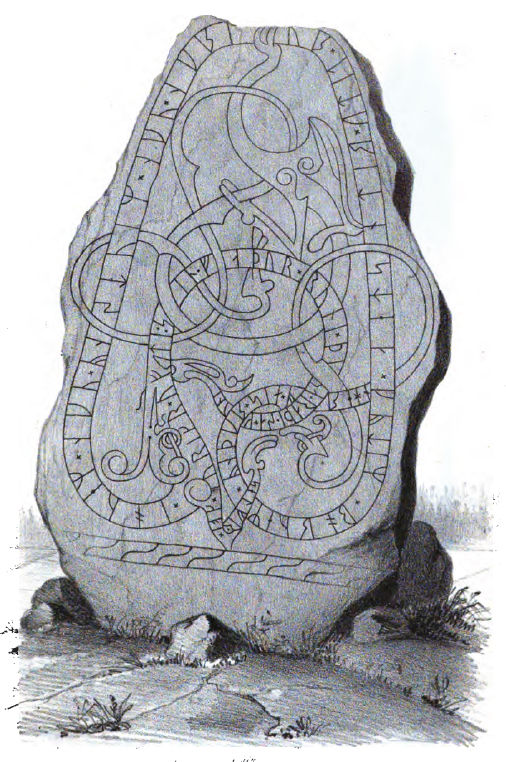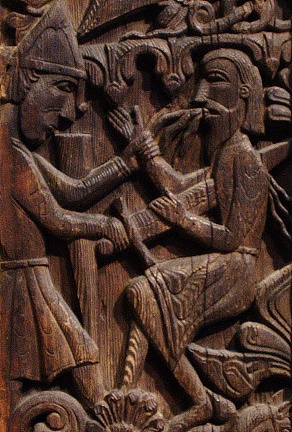|
Hylestad Stave Church
The Hylestad Stave Church was a stave church located in Hylestad (now Valle municipality), Setesdal district, Norway. The church was estimated to have been built in the late 12th to the early 13th century and was demolished in the 17th century. Some of the intricate wood carvings from the church doorway were saved and incorporated into other buildings. They are now on display at the Museum of Cultural History in Oslo. The carvings show several scenes from the legend of Sigurd Fåvnesbane. A section of one of these carvings in which Sigurd kills Regin was the basis for a Norwegian postal stamp. Engravings There are seven scenes from the Sigurd legend carved on the two door panels, with three scenes on the first panel and four scenes on the second panel. The description below notes the scenes and the corresponding section from the legend, with the order of the fifth and sixth scenes reversed to follow the normal sequence of the legend. Based on the clothes and equipment, the pa ... [...More Info...] [...Related Items...] OR: [Wikipedia] [Google] [Baidu] |
Stave Church
A stave church is a medieval wooden Christian church building once common in north-western Europe. The name derives from the building's structure of post and lintel construction, a type of timber framing where the load-bearing ore-pine posts are called ''stafr'' in Old Norse (''stav'' in modern Norwegian). Two related church building types also named for their structural elements, the post church and palisade church, are often called 'stave churches'. Originally much more widespread, most of the surviving stave churches are in Norway. The only remaining medieval stave churches outside Norway are those of ''circa'' 1500 Hedared stave church in Sweden and one Norwegian stave church relocated in 1842 to contemporary Karpacz in the Karkonosze mountains of Poland (at the time being a part of the Kingdom of Prussia). One other church, the Anglo-Saxon Greensted Church in England, exhibits many similarities with a stave church but is generally considered a palisade church. Construct ... [...More Info...] [...Related Items...] OR: [Wikipedia] [Google] [Baidu] |
Germanic Dragon
Dragons are present in Germanic mythology and folklore, where they are often portrayed as large venomous serpents. Especially in later tales, however, they share many common features with other dragons in European mythology. Origin, appearance and terminology In early depictions, as with dragons in other cultures, the distinction between Germanic dragons and regular snakes is blurred, with both being referred to as Old Norse or Old English from Proto-Germanic *wurmiz. ''Wyrm'' has since been borrowed back into Modern English to mean "dragon", while the descendent term ''worm'' remains used in Modern English to refer to dragons, especially those lacking wings. In Fáfnismál, the dragon Fáfnir is described as flightless and snake-like, and is referred to as an . In the later Völsunga saga, however, he has shoulders, suggesting legs, wings or both, and is referred to as both a and an . Similarly, the dragon in Beowulf is referred to as both a and a , although in some s ... [...More Info...] [...Related Items...] OR: [Wikipedia] [Google] [Baidu] |
Viking Art
Viking art, also known commonly as Norse art, is a term widely accepted for the art of Scandinavian Norsemen and Viking settlements further afield—particularly in the British Isles and Iceland—during the Viking Age of the 8th-11th centuries. Viking art has many design elements in common with Celtic, Germanic, the later Romanesque and Eastern European art, sharing many influences with each of these traditions. Generally speaking, the current knowledge of Viking art relies heavily upon more durable objects of metal and stone; wood, bone, ivory and textiles are more rarely preserved. The artistic record, therefore, as it has survived to the present day, remains significantly incomplete. Ongoing archaeological excavation and opportunistic finds, of course, may improve this situation in the future, as indeed they have in the recent past. Viking art is usually divided into a sequence of roughly chronological styles, although outside Scandinavia itself local influences are ofte ... [...More Info...] [...Related Items...] OR: [Wikipedia] [Google] [Baidu] |
Sigurd Stones
The Sigurd stones form a group of eight or nine Swedish runic inscriptions (five or six runestones, two natural rocks, and a baptismal font) and one picture stone that depict imagery from the Germanic heroic legend of Sigurd the dragon slayer. They were made during the Viking Age and constitute the earliest Norse representations of the matter of the Völsung cycle that is the basis of the Middle High German ''Nibelungenlied'' and the Sigurd legends in the ''Poetic Edda'', the ''Prose Edda'', and the ''Völsunga saga''. In addition, the figure of Sigurd sucking the dragon's blood from his thumb appears on several carved stones in parts of Great Britain that were under Norse culture: at Ripon and Kirby Hill, North Yorkshire, at York and at Halton, Lancashire, and carved slates from the Isle of Man, broadly dated , include several pieces interpreted as showing episodes from the Sigurd story. Uppland U 1163 This runestone is in runestone style Pr2. It was found in Drävle, bu ... [...More Info...] [...Related Items...] OR: [Wikipedia] [Google] [Baidu] |
Grani
In Scandinavian heroic legend, Grani (Old Norse: ) is a horse owned by the hero Sigurd. He is the horse that Sigurd receives through advice from the Norse god (Odin). Grani is a descendant of Odin's own steed, Sleipnir. Attestations In chapter 13 of ''Völsunga saga'', the hero Sigurðr is on his way to a wood when he meets a long-bearded old man he had never seen before. Sigurd tells the old man that he is going to choose a horse, and asks the old man to come with him to help him decide. The old man says that they should drive the horses down to the river Busiltjörn. The two drive the horses down into the deeps of Busiltjörn, and all of the horses swim back to land but a large, young, and handsome gray horse that no one had ever mounted. The grey-bearded old man says that the horse is from "Sleipnir's kin" and that "he must be nourished heedfully, for it will be the best of all horses". The old man vanishes. Sigurd names the horse Grani, and the narrative adds that the old ma ... [...More Info...] [...Related Items...] OR: [Wikipedia] [Google] [Baidu] |
Sigurd Fåvnesbane
Sigurd ( non, Sigurðr ) or Siegfried (Middle High German: ''Sîvrit'') is a legendary hero of Germanic heroic legend, who killed a dragon and was later murdered. It is possible he was inspired by one or more figures from the Frankish Merovingian dynasty, with Sigebert I being the most popular contender. Older scholarship sometimes connected him with Arminius, victor of the Battle of the Teutoburg Forest. He may also have a purely mythological origin. Sigurd's story is first attested on a series of carvings, including runestones from Sweden and stone crosses from the British Isles, dating from the eleventh century. In both the Norse and continental Germanic tradition, Sigurd is portrayed as dying as the result of a quarrel between his wife ( Gudrun/Kriemhild) and another woman, Brunhild, whom he has tricked into marrying the Burgundian king Gunnar/Gunther. His slaying of a dragon and possession of the hoard of the Nibelungen is also common to both traditions. In other respe ... [...More Info...] [...Related Items...] OR: [Wikipedia] [Google] [Baidu] |
Hylestad - Sigurd Sucking Thumb
Hylestad is a former municipality in the old Aust-Agder county in Norway. The former municipality existed from 1915 until its dissolution in 1962. It was located in the southern part of the present-day municipality of Valle in the traditional region of Setesdal in Agder county. The administrative centre was the village of Rysstad where the Hylestad Church was located. History The parish of Hylestad was established as a municipality on 1 July 1915 when the municipality of Valle was divided into two municipalities: Hylestad (population: 658) in the south and Valle (population: 1,051) in the north. During the 1960s, there were many municipal mergers across Norway due to the work of the Schei Committee. On 1 January 1962, Hylestad was reincorporated into Valle. Prior to the merger Hylestad had a population of 662. Name The municipality (originally the parish) was named after the old ''Hylestad'' farm ( non, Hyljastaðir), since the first Hylestad Church was built there. The first e ... [...More Info...] [...Related Items...] OR: [Wikipedia] [Google] [Baidu] |
Gram (mythology)
In Norse mythology, Gram (Old Norse ''Gramr'', meaning "Wrath"), also known as Balmung or Nothung, is the sword that Sigurd used to kill the dragon Fafnir. It is primarily used by the Völsungs in the ''Volsunga Saga''. However, it is also seen in other legends, such as the ''Thidrekssaga'' in which it is wielded by Hildebrand. Depending on the story and source material, Gram may have other names. In ''The Nibelungenlied'' it is named Balmung. In Richard Wagner's work, ''Der Ring des Nibelungen'' (''The Ring of the Nibelung''), it is referred to as Nothung. Description Nowhere in the ''Volsunga Saga'' is a clear description of Gram given, but there is enough scattered throughout the story to draw a picture of the sword. Sigurd's weapons, Gram included, are described as being "all decked with gold and gleaming bright". Depending on how the text is read, the sword may or may not have a dragon emblazoned on it and/or depending on the translation been "brown of hue". History ... [...More Info...] [...Related Items...] OR: [Wikipedia] [Google] [Baidu] |
Hylestad
Hylestad is a former municipality in the old Aust-Agder county in Norway. The former municipality existed from 1915 until its dissolution in 1962. It was located in the southern part of the present-day municipality of Valle in the traditional region of Setesdal in Agder county. The administrative centre was the village of Rysstad where the Hylestad Church was located. History The parish of Hylestad was established as a municipality on 1 July 1915 when the municipality of Valle was divided into two municipalities: Hylestad (population: 658) in the south and Valle (population: 1,051) in the north. During the 1960s, there were many municipal mergers across Norway due to the work of the Schei Committee. On 1 January 1962, Hylestad was reincorporated into Valle. Prior to the merger Hylestad had a population of 662. Name The municipality (originally the parish) was named after the old ''Hylestad'' farm ( non, Hyljastaðir), since the first Hylestad Church was built there. The first e ... [...More Info...] [...Related Items...] OR: [Wikipedia] [Google] [Baidu] |
Regin
In Norse mythology, Reginn (Old Norse: ᚱᛁᚼᛁᚾ/ᚱᛁᚽᛁᚿ ; often anglicized as Regin or Regan) is a son of Hreiðmarr and the foster father of Sigurd. His brothers are Fafnir and Ótr. Regin in the sagas When Loki mistakenly kills Ótr, Hreiðmarr demands to be repaid with the amount of gold it takes to fill Ótr's skin and cover the outside. Loki takes this gold from the dwarf Andvari, who curses it and especially the ring Andvaranaut. Fafnir kills his father for this gold, but eventually becomes a greedy dragon. Reginn gets none of the gold, but he becomes smith to the king and foster father to Sigurd, teaching him many languages as well as sports, chess, and runes. Reginn had all wisdom and deftness of hand. Of his two brothers, he has the ability to work iron as well as silver and gold and he makes many beautiful and useful things. While Sigurd is living with Reginn, Reginn challenges Sigurd's respect in the kingdom. He tells Sigurd to ask for a horse. Si ... [...More Info...] [...Related Items...] OR: [Wikipedia] [Google] [Baidu] |







